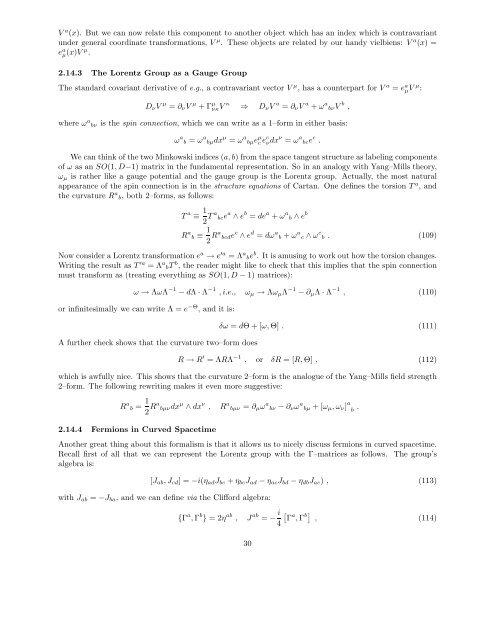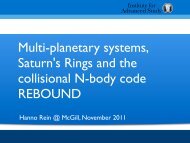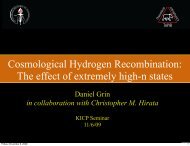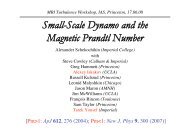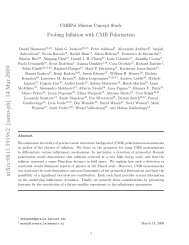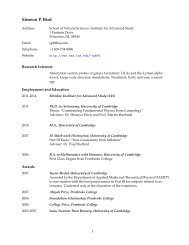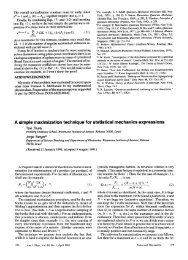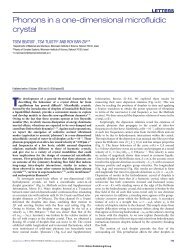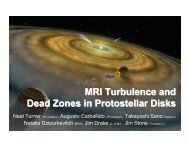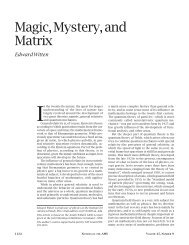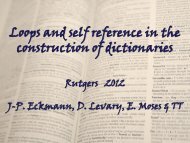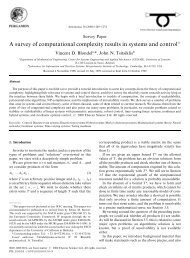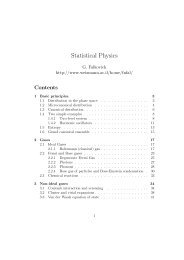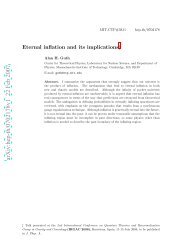Introduction to String Theory and D–Branes - School of Natural ...
Introduction to String Theory and D–Branes - School of Natural ...
Introduction to String Theory and D–Branes - School of Natural ...
Create successful ePaper yourself
Turn your PDF publications into a flip-book with our unique Google optimized e-Paper software.
V a (x). But we can now relate this component <strong>to</strong> another object which has an index which is contravariant<br />
under general coordinate transformations, V µ . These objects are related by our h<strong>and</strong>y vielbiens: V a (x) =<br />
e a µ (x)V µ .<br />
2.14.3 The Lorentz Group as a Gauge Group<br />
The st<strong>and</strong>ard covariant derivative <strong>of</strong> e.g., a contravariant vec<strong>to</strong>r V µ , has a counterpart for V a = e a µ V µ :<br />
DνV µ = ∂νV µ + Γ µ νκV κ ⇒ DνV a = ∂νV a + ω a bνV b ,<br />
where ω a bν is the spin connection, which we can write as a 1–form in either basis:<br />
ω a b = ω a bµdx µ = ω a bµe µ c e c νdx ν = ω a bce c .<br />
We can think <strong>of</strong> the two Minkowski indices (a, b) from the space tangent structure as labeling components<br />
<strong>of</strong> ω as an SO(1, D−1) matrix in the fundamental representation. So in an analogy with Yang–Mills theory,<br />
ωµ is rather like a gauge potential <strong>and</strong> the gauge group is the Lorentz group. Actually, the most natural<br />
appearance <strong>of</strong> the spin connection is in the structure equations <strong>of</strong> Cartan. One defines the <strong>to</strong>rsion T a , <strong>and</strong><br />
the curvature R a b, both 2–forms, as follows:<br />
T a ≡ 1<br />
2 T a bce a ∧ e b = de a + ω a b ∧ e b<br />
R a b ≡ 1<br />
2 Ra bcde c ∧ e d = dω a b + ω a c ∧ ω c b . (109)<br />
Now consider a Lorentz transformation e a → e ′a = Λ a be b . It is amusing <strong>to</strong> work out how the <strong>to</strong>rsion changes.<br />
Writing the result as T ′a = Λ a bT b , the reader might like <strong>to</strong> check that this implies that the spin connection<br />
must transform as (treating everything as SO(1, D − 1) matrices):<br />
ω → ΛωΛ −1 − dΛ · Λ −1 , i.e., ωµ → ΛωµΛ −1 − ∂µΛ · Λ −1 , (110)<br />
or infinitesimally we can write Λ = e −Θ , <strong>and</strong> it is:<br />
A further check shows that the curvature two–form does<br />
δω = dΘ + [ω, Θ] . (111)<br />
R → R ′ = ΛRΛ −1 , or δR = [R, Θ] , (112)<br />
which is awfully nice. This shows that the curvature 2–form is the analogue <strong>of</strong> the Yang–Mills field strength<br />
2–form. The following rewriting makes it even more suggestive:<br />
R a b = 1<br />
2 Ra bµνdx µ ∧ dx ν , R a bµν = ∂µω a bν − ∂νω a bµ + [ωµ, ων] a<br />
b .<br />
2.14.4 Fermions in Curved Spacetime<br />
Another great thing about this formalism is that it allows us <strong>to</strong> nicely discuss fermions in curved spacetime.<br />
Recall first <strong>of</strong> all that we can represent the Lorentz group with the Γ–matrices as follows. The group’s<br />
algebra is:<br />
[Jab, Jcd] = −i(ηadJbc + ηbcJad − ηacJbd − ηdbJac) , (113)<br />
with Jab = −Jba, <strong>and</strong> we can define via the Clifford algebra:<br />
{Γ a , Γ b } = 2η ab , J ab = − i a b<br />
Γ , Γ<br />
4<br />
, (114)<br />
30


